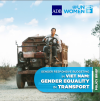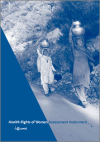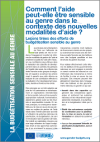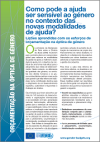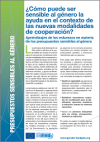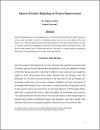FOUND 120 RESULTS
Drawing on international examples, and in consultation with the Viet Nam Ministry of Transport officials, this paper highlights the importance of a gender responsive budgeting (GRB) approach and explores how to implement it in the transport sector in Viet Nam.
The Health Rights of Women Assessment Instrument (HeRWAI) is a tool developed by the Humanist Committee on Human Rights (HOM) in 2006 to enhance lobbying activities for better implementation of women's health rights. A HeRWAI analysis links what actually happens with what should happen according to the human rights obligations of a country.
The Paris Declaration on Aid Effectiveness (PD) commits donors and partner countries to reform aid management and delivery in order to strengthen its development outcomes. Through the Declaration, development partners commit to implementing common arrangements for planning, funding, disbursing, monitoring, evaluating and reporting on donor activities and aid flows at country level. To respond to these requirements, donors have collectively put in place a number of mechanisms to better coordinate...
The Paris Declaration on Aid Effectiveness (PD) commits donors and partner countries to reform aid management and delivery in order to strengthen its development outcomes. Through the Declaration, development partners commit to implementing common arrangements for planning, funding, disbursing, monitoring, evaluating and reporting on donor activities and aid flows at country level. To respond to these requirements, donors have collectively put in place a number of mechanisms to better coordinate...
The Paris Declaration on Aid Effectiveness (PD) commits donors and partner countries to reform aid management and delivery in order to strengthen its development outcomes. Through the Declaration, development partners commit to implementing common arrangements for planning, funding, disbursing, monitoring, evaluating and reporting on donor activities and aid flows at country level. To respond to these requirements, donors have collectively put in place a number of mechanisms to better coordinate...
This paper provides guidance on how to make Public Finance Management (PFM) reforms gender responsive. It presents an overview of PFM reforms and explains how and why they are important to the achievement of gender equality outcomes. The paper aims to link ongoing work on gender responsive budgeting (GRB) with broader PFM reform efforts by increasing understanding of GRB among PFM practitioners and increasing understanding of PFM reforms among gender experts to support better results for gender equality and women's empowerment.
Well-being gender budgeting (WBGB) experiences use a multidimensional approach for planning and budgeting combining the Capability Approach along with gender responsive budgeting. However, what happens to the other well-being budgeting initiatives that do not explicitly include this «gender focus» in their conceptualization? This article explores the gender biases that can be found in well-being budgeting and the challenges of integrating a gender perspective into these practices. It...
This synthesis paper examines the evolution of efforts to address domestic violence in Latin America. In the outset, the authors elucidate the methodological dilemmas involved in collecting data on domestic violence. The paper discusses some of the outcomes of domestic violence laws, including government actions undertaken, strategies used to implement laws when funding is lacking, and the extent of domestic violence services resulting from domestic violence laws. The paper also provides a...
This synthesis paper examines the evolution of efforts to address domestic violence in Latin America. In the outset, the authors elucidate the methodological dilemmas involved in collecting data on domestic violence. The paper discusses some of the outcom
This paper is an attempt to measure the effectiveness of Gender Budgeting as a tool for women empowerment. In recent years, Gender Budget Initiatives have emerged as an effective way to bridge gender gaps. First step towards this goal was taken by Australia, South Africa and Philippines followed by other developed and less developed countries including India.
